The Beat Goes On
As they say, all good things must come to an end, and this was true of the original Rockers as we eventually went our separate ways.
I was looking for a day gig to get me by until I could get a band back together when I got one of the biggest breaks of my life. Bob Middendorf of Creative Printers in Quincy, Illinois hired me on as a commercial artist. That’s what they called graphic designers back in those days. I’m not even sure why he hired me. My portfolio at this time pretty much consisted of rock n’ roll posters along with the technical drawings I had done for automotive assembly design. For whatever reason, Bob took me under his wing and became my mentor. He taught me everything he knew about graphic design and printing. After I’d been with him for a while, he made me a partner in Creative Advertising.

T’N’T Raceway’s track announcer Paul Butler presenting the Point Championship trophies to Freddie Tieken in 1962.

National Karting Championship trophy winners, West Quincy, Mo. Freddie, kneeling, fourth from left.
It was about this same time that I got interested in kart racing. I would travel all over the country with my dad and brother Dennis to race on different tracks. Dennis also raced and my dad was our mechanic. Sometimes I would drive all night after a gig with my band in order to run a 100-lap enduro the next day. Gus Traeder opened T’N’T Raceways in West Quincy, Missouri where I became Point Champion and won the Single Engine National Championship.
It wasn’t unusual for me to race all day at T’N’T and then go back that night with the Rockers and play an outdoor dance. Every time that we played the track it was like a festival and that’s where our second album, Freddie Tieken & The Rockers Live, was recorded.
All my life I’ve been blessed. Whether I was involved in music, art and design, or racing, there was always someone there to encourage and mentor me. When I look back, I don’t know how I had the energy to do so many different things at the same time. I guess I drew my energy from the people around me and from the excitement of my accomplishments.
After the original Rockers disbanded, it didn’t take me long to get a new group rehearsed and ready to roll. I started getting a lot of phone calls at work. Bob was so cool about it — he had a separate phone line put in for me to conduct my music business.

Vernie Robbins joined the band in 1960, replacing Wild Child on vocals and keyboards. She had three kids during her stint with our band. She would play all night at a gig and have labor pains on the way home, sometimes hundreds of miles away. Vernie was a real trooper. She had those kids and never missed a beat.
Clete Webster filled in on drums when Ron Davis left to tour with Dick Clark’s Caravan of Stars. Jim Vandement became the drummer the following year. It was also during that time that Forrest Moore replaced Mark Millspaugh on bass.
Freddie Tieken & the Rockers, circa 1961. From left, Mark Millspaugh, Freddie, Vernie Robbins and Jim Vandement.
Across the Mississippi River from Burlington, Iowa sits Gulfport, Illinois where several nightclubs along a gravel road stayed open until 4:00 am. We did a week engagement at one of them and at the end of the gig our drummer had to sell his drums to the club owner to pay for his bar tab. He had just gotten married and he and his new wife decided he didn’t want to play drums anymore, so I went back to the club the following week and bought the red sparkle Slingerlands for my brother Dennis. It was his first real professional drum kit and I think he was about 12 years old then.

Young Dennis Tieken with his first professional drum set.

Laying down tracks for the “By Popular Demand” album, 1963.
In 1963, I met a high school student named Jack Inghram who had been hanging around the band pestering me for a chance to play sax and keyboards with us. Jack just happened to own some really advanced recording equipment for those days so, together, we set up the band along with Jack’s recording equipment in the fellowship hall of the First Union Congregational Church. We used the sanctuary as a natural echo chamber and laid down some incredible tracks.
From this session, Freddie Tieken & the Rockers’ first album, By Popular Demand, was born and the band had a new member, young Jack Inghram.
It took Jack a while to develop his stage presence. I remember him playing with one hand while the other hand held a big white hanky to his nose. There he would be, searching for buggers with a blank look on his face, but never missing a beat.
Wand/Scepter Records, a New York-based label with artists such as the Kingsmen and Dionne Warwick, wanted to sign us to their label and sent a contract for me to sign. Jack’s dad who was an attorney said he would look it over and I never saw that contract again. I realized later that he did that because he wanted his son Jack to pursue a career in law and not in rock’n’roll. I think about that now and then and I always wonder how things might have turned out had I signed with a major label at that point in my life.

On stage, in concert, big crowds every night.
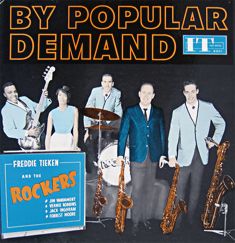
We actually made some money off our first album sales and with my profits I was able to put a studio in my basement in Quincy. Jack and I founded IT Records, a small, independent label. The Rockers’ popularity was inspiring a whole new generation of younger Midwest musicians to start their own bands and Jack and I produced dozens of singles and several albums for these groups on the IT label.
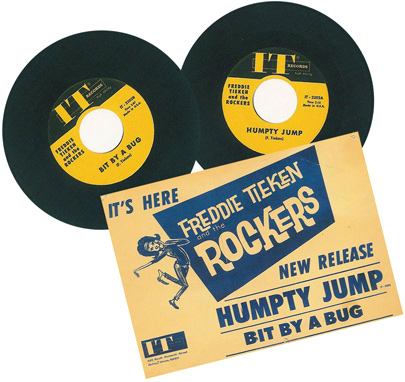
We did sessions for Plato & the Philosophers, State of Confusion the Gonn and the Intruders. A country artist from Chicago, Johnny McCullough, heard about the studio and came to Quincy to record. Wild Child even brought his new group in to lay down some tracks. A couple of Freddie Tieken & the Rockers singles were recorded there. To this day, we still get requests from collectors all over the world looking for anything that was recorded on IT Records.

IT Records recorded many Midwestern artists throughout the 1960s.

Meanwhile we continued our rigorous touring schedule. We played mostly one-nighters but, for a couple of years, Friday nights belonged to the Pla-Mor Club in East Hannibal, Ill. where the crowds were of such proportions that if you didn’t get there early, you just didn’t get in.

I remember one night we were playing at a club in Columbia, Missouri and the place was so packed you could hardly breathe. We were standing outside during break and heard some great sounding music coming from a very small club next door. We walked into that bar and there was a handful of people listening to Howlin’ Wolf! There’s just no justice in the music business.
 The Rockers’ popularity continued to grow and our performances at T’N’T Raceways would draw thousands of young fans who weren’t old enough for the nightclub scene. At one of these gigs in 1965 we recorded our second album, Live. Ron Lepper joined the group about that time and played guitar on the album. Diane and Donna Rogan sang backup vocals for the album and eventually replaced Vernie Robbins in the band.
The Rockers’ popularity continued to grow and our performances at T’N’T Raceways would draw thousands of young fans who weren’t old enough for the nightclub scene. At one of these gigs in 1965 we recorded our second album, Live. Ron Lepper joined the group about that time and played guitar on the album. Diane and Donna Rogan sang backup vocals for the album and eventually replaced Vernie Robbins in the band.

A performance by Freddie & the Rockers draws thousands of fans to the opening of Sandy’s, ushering in the era of the 17¢ hamburger in Quincy, Ill.

The crowd goes wild for the band at T’N’T Raceways.

Freddie Tieken & the Rockers at Turner Hall.

The Shangri-Las backed by Freddie Tieken & the Rockers.

We used to play at this place way out in the cornfields in central Illinois called the Benld Coliseum. It was a huge ballroom, holding about 5,000 people, with a gigantic stage in the middle of nowhere. The woman who had run the place forever seemed kind of hard-nosed and we eventually learned why. The place had been owned by Al Capone and the mob, and at one time this was their hangout. After we found that out, we could almost feel their presence in the room. It was kind of freaky.

Clockwise from upper left: Four-year-old Freddie in 1939, four-year-old Dennis in 1956, 17-year-old Dennis in 1969, 34-year-old Freddie in 1969
About this time my teenage brother Dennis Tieken joined the band on drums. He was pretty young at the time, but it took him about three hours after joining the band to grow up. Dennis grew to become a big influence on me and on the band over the years.
Jack Inghram, Ron Lepper and I all had high-powered motorcycles and after many gigs we would head to the expressway and drag race anyone who was interested until the wee hours of the morning. When I look back, I can’t believe I lived to tell this and certainly wouldn’t advise it to any readers.
Sometimes Jack would borrow his dad’s single engine plane and he and I would fly to gigs together. I especially remember one time when we were playing a teen club in Burlington, Iowa. Although the thermometer read 0° when we took off, the flight to Burlington was uneventful. By the time we were ready to fly back to Quincy at 2:00 am, the temperature had dropped to -10° and the plane’s gas line had frozen. So there we were out on the runway, spinning the prop by hand while shooting ether into the carburetor. It finally coughed a few times and started up so we jumped in the plane and took off. The plane had no navigation instruments and it was pitch black that night so it was a challenge to follow the Mississippi River back to Quincy. The plane coughed and sputtered and almost stalled out a couple of times along the way, but we made it home. We just didn’t think about how crazy it was then, but looking back it seems a miracle that we’re alive.
Musicians that were a part of the Rockers at one time or another include Ron Shumake on bass. Ron left the group when he joined the army but returned to play with my brother’s band a few years later. In the seventies, Ron moved to California and has since played with many famous artists including Willie Nelson, Roger Miller and Canned Heat.

Freddie Tieken & the Rockers, circa 1967, from left: Freddie, Jack Inghram, Dennis Tieken, Rick Ruggerio, Gary Hendren (seated)
For more than a decade, Freddie Tieken & the Rockers appeared at just about every nightclub, teen dance, coliseum, hall, gymnasium, ballroom, roller-skating rink, flatbed truck, frat party and prom in the central Midwest. We also covered the state and county fair circuit, playing with such groups as Sam the Sham & the Pharaohs and Tommy Rydell.
Rick Ruggerio, a Culver Stockon College student from New York, joined the Rockers on guitar after we drove over to Canton, Missouri to hear him play. Other band members included Rod Hibbert (of Rod & the Satellites) on guitar, Gary Hendron on bass and Curt Wacholz on keyboards. Les Fonza played baritone sax and Ron Schaller played trumpet during the last years of the Rockers.

One of many teen dances played throughout the Midwest.

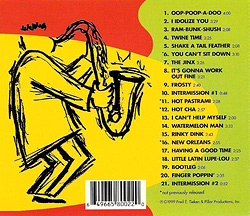
For more than a decade, Freddie Tieken & the Rockers appeared at just about every nightclub, teen dance, coliseum, hall, gymnasium, ballroom, roller-skating rink, flatbed truck, frat party and prom in the central Midwest. We also covered the state and county fair circuit, playing with such groups as Sam the Sham & the Pharaohs and Tommy Rydell.
There were no musical pigeonholes in those days. No black music. No white music. No heavy metal. No alternative. It was all just rock’n’roll and you knew when The Rockers rolled into town there was going to be a party.
The Times They Are a-Changin’
The late sixties were a time of great social change in America and my music fell under the influence of these changes. I decided it was time to break with the past and changed the name of my group to Freddie Tieken’s American Music Band.
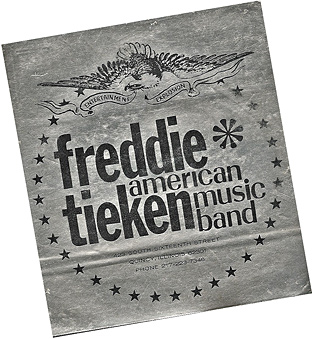

An outdoor concert with the last version of Freddie Tieken & the Rockers, from left: Rod Hibbert, guitar & vocals; Dennis Tieken, drums; Freddie, tenor sax & vocals; Les Fonza, baritone sax; Ron Schaller, trumpet; Ron Shumake, bass; Jack Inghram, keyboards & sax.

Freddie Tieken’s American Music Band, circa late 1960s. From left (standing): Les Fonza, Billy Wicks, Russ Phillips, Bix Clements, Ron Schaller. From left (seated): Dennis Tieken, Freddie, Slink Rand.
The 8-piece band featured an extremely tight horn section – Russ Phillips from Chicago on trombone, Ron Schaller on trumpet, Les Fonza on baritone sax and myself on tenor sax.
Bix Clements came down from Detroit about that time and joined the band on bass. What a great guy Bix was and a major influence on the band as well. He had a big-city attitude and was a very funny guy. Bix and I remained good friends for years after his stint in the band ended and we were all saddened by his untimely death in the early nineties.
Slink Rand, a young guitarist from Carthage, Illinois, joined the group and my brother Dennis Tieken, who was still too young to be playing nightclubs, played drums. I hired a singer, Billy Wicks from Springfield, to add a different dimension to the group. Billy met an early death in a car wreck a few years later.
We covered songs by groups such as Blood, Sweat & Tears and Electric Flag, but we were also experimenting a lot with original material that combined traditional soul and R&B sounds with our new instrumentation and musical influences.
It was about this time that a good friend of mine, Mike Wendling, started booking the band. He got us a gig at Beavers in Chicago’s Rush Street district where all the major groups played. It wasn’t unusual to look around and see Rod Stewart standing next to you and it seemed like the Allman Brothers were on the bill about every other week or so. After our engagement, Buddy Miles followed us in.

In the early 1970s, Beavers on Chicago’s Rush Street was a popular venue for many top bands of that era.
Mike shared an apartment across the street from Beavers with another good friend, Denny Juette. Their rooftop was the place to be for partying and people watching. Rush Street really hasn’t changed that much. There were young people everywhere. Their apartment was above a club called Lolly’s and I remember that Dr. John was playing when we were there.
For a short time, I rented Turner Hall and turned it into a large nightclub. I called it the ZigZag Club and installed lots of psychedelic effects such as black lights, strobe lights and dissolving images from looped projectors dancing on the walls. I thought it would be the perfect setting for the American Music Band with our alternative hippy image.
Opening night went really well and we had a pretty good crowd. The second night only two people showed up — my future wife Gail and her friend Cindy Altgilbers.
Of course, we played all three sets as though the place was packed but it did make me rethink the nightclub idea. This was years before Studio 54 and I guess I was in the wrong place at the wrong time.
It was a great time musically, but we had a hard time fitting in. Rockers fans who came to our gigs expecting the old song list were disappointed. A lot of our new tunes were not exactly danceable material and that had been a large part of the Rockers’ appeal in the day.
We were building a new fan base of mostly college students and counter-culture types but it was hard being on the road with eight mouths to feed. The horn section eventually left to pursue their respective educations and to get jobs where they could actually make some money.
ILMO Smokehouse
 I was driving across the bridge that spans the Mississippi River from Quincy, Illinois to West Quincy, Missouri one day when I noticed an old, faded sign on a dilapidated building down on Front Street by the river. I could barely make out the words, ILMO Smokehouse. I couldn’t get those words out of my mind. I mentioned it to some friends and was told it had been a house of ill repute at one time. That was all I needed to hear. I had been thinking about a new name for the band to signal a new beginning without the horn section and ILMO Smokehouse was born. The rest of the group hated the name at first but I think they eventually warmed to it. Dennis and Slink stayed with me from American Music Band. When Bix moved back to Detroit, I hired Craig Moore on bass and Gerry Gable on keyboards.
I was driving across the bridge that spans the Mississippi River from Quincy, Illinois to West Quincy, Missouri one day when I noticed an old, faded sign on a dilapidated building down on Front Street by the river. I could barely make out the words, ILMO Smokehouse. I couldn’t get those words out of my mind. I mentioned it to some friends and was told it had been a house of ill repute at one time. That was all I needed to hear. I had been thinking about a new name for the band to signal a new beginning without the horn section and ILMO Smokehouse was born. The rest of the group hated the name at first but I think they eventually warmed to it. Dennis and Slink stayed with me from American Music Band. When Bix moved back to Detroit, I hired Craig Moore on bass and Gerry Gable on keyboards.

The original ILMO Smokehouse in 1969, from left: Slink Rand, Dennis Tieken, Fred, Gerry Gabel, Craig Moore
I bought a bus from Kirksville, Missouri regional bus lines and converted it into a touring bus for the band. It was large enough to carry the band, our equipment, and anyone else who dared to step on board. On the back I painted the “ILMO Lady” and she became the band’s mascot. (See the Transportation section for more about the bus.)
We developed an original repertoire of extremely heavy, psychedelic blues/rock material. Cary Baker, a music critic and friend of mine, once quoted me as saying that we were a cross between Cream and James Brown. When I think about it, the description fits pretty well. Whatever it was, it seemed right for the times. We were gaining popularity with an all new generation of young people who shared our somewhat contrarian views of society and we soon started drawing thousands of people to our shows.
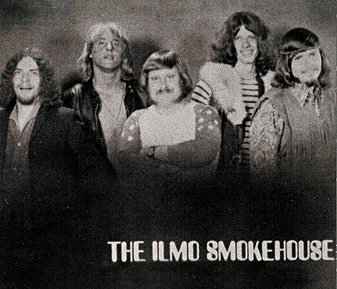
With ILMO Smokehouse, Fred shortened his name and took his band in a whole new direction.
The bus stood out way too much and we were always getting stopped by the police or assaulted by rednecks. On one occasion, we were stopped by the police as we approached the campus of Northeast Missouri State College where we were headlining a concert. Under the pretext of a bomb threat, they searched the entire bus and its contents and even strip-searched everyone on board. They found two joints on one of the band members but said they would let him go since it was a bomb they were looking for.
We played that night to a very large and enthusiastic crowd of college students. As we were leaving the stage, the police walked up and hand cuffed the band member who had been found with the joints. Well, the crowd went berserk. They followed us to the police station where they proceeded to overturn cars and to throw rocks and bottles at the police. I guess I didn’t realize how volatile the situation was. I walked out in the middle of all this to ask the mob to remain calm. As I turned around, I was face-to-face with a row of badges and shotguns. Well, I ducked into the crowd and decided that, from that night on, the role of peacemaker was not my calling. The next day, we got a lawyer, freed the band member and went on to the next gig.
We were a very loud band and occasionally that would get us in trouble with city officials. The Mayor of Centerville, Iowa once walked up to the stage and told us to turn down or he would shut us down. Without even thinking, I walked over to the mic and told the crowd that their asshole mayor had just given us an ultimatum. The crowd started yelling and booing at the mayor and it was turning ugly so I decided it was time to pack up and head out.
We were talking about producing an album and a local entrepreneur and fan of the band, Greg Eversden, agreed to provide the financial backing for a recording session. We piled into the ILMO bus and headed to Memphis where we recorded an album’s worth of material at Beautiful Sounds studio.


Fred lays down tracks at Beautiful Sounds Studio in Memphis while Dan Penn works the console.
The studio’s owner was the legendary producer/songwriter Dan Penn who had worked with the likes of Janis Joplin, The Boxtops and BJ Thomas. The conditions were less than ideal. We essentially had 32 hours of recording time in which to produce an album’s worth of songs. We went straight through the day, into the night and the next day. I had to sing vocals on one cut lying down. ILMO Smokehouse was a very powerful and charismatic band onstage and I’ve always regretted that these recordings did not capture our power.
We took the tapes from the session and put out an independent album on the Beautiful Sounds label titled “ILMO Smokehouse.” It sold fairly well throughout the Midwest and became a staple of many underground FM playlists. KNIX in St. Louis, Missouri played the heck out of it and got us a lot of interest from major record labels. KAAY from Little Rock, Arkansas used “Movement 1 & 13” from the album as a lead-in for their evening segment every night for a long time. That was a thrill I’ll always remember, to be driving along and hear our song being used as a nightly anthem calling out to a restless generation of young people.
ILMO Smokehouse Album Insert
 Light a candle in the dark and give birth to dawn and with the dew end the thirst of the rose, stand fast for the right and bring death to the wrong and stick to the path that you chose. The earth feeds man as Mother Nature starves and nations butcher nations for greed – Our homeland has died on the cross at Wall Street and was buried in our time of need. It may take time, it may take sweat, it may take tears and blood but for man to live and know love and peace we must resurrect America. So turn your back on the goblins of this century – turn your back on the society that forced these words from me – Turn back to the Spirit of ’76. See the people turn and fight their way back up the hill, tired of running, jumping, doing others’ will – See the guard kneel, M-1s level with the ground, what are you going to do while they shoot your people down?
Light a candle in the dark and give birth to dawn and with the dew end the thirst of the rose, stand fast for the right and bring death to the wrong and stick to the path that you chose. The earth feeds man as Mother Nature starves and nations butcher nations for greed – Our homeland has died on the cross at Wall Street and was buried in our time of need. It may take time, it may take sweat, it may take tears and blood but for man to live and know love and peace we must resurrect America. So turn your back on the goblins of this century – turn your back on the society that forced these words from me – Turn back to the Spirit of ’76. See the people turn and fight their way back up the hill, tired of running, jumping, doing others’ will – See the guard kneel, M-1s level with the ground, what are you going to do while they shoot your people down?
The ILMO Smokehouse album was picked up, re-mixed and re-released with my original artwork and packaging by New York’s Roulette Records whose big act at the time was Tommy James & the Shondells. As was often the case in those days, we found ourselves in company that didn’t really understand us or our music. Roulette was a very powerful label at the time and they seemed more interested in worldwide distribution than in capitalizing on the fan base we had already established throughout the middle U.S. The album was featured in Billboard Magazine as a Spotlight Pick, but the momentum didn’t last. Ironically, the album did become a hit in Spain, a country experiencing social unrest at the time.
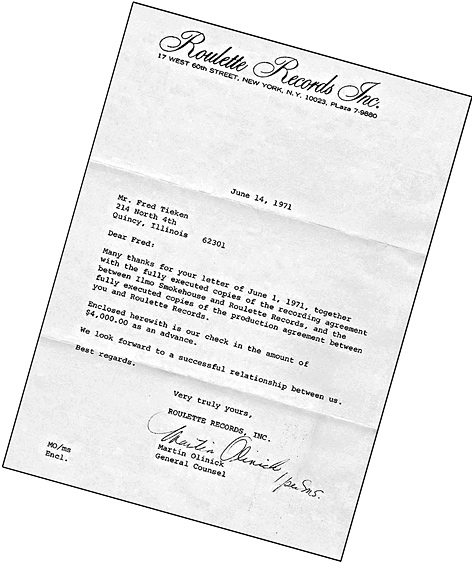
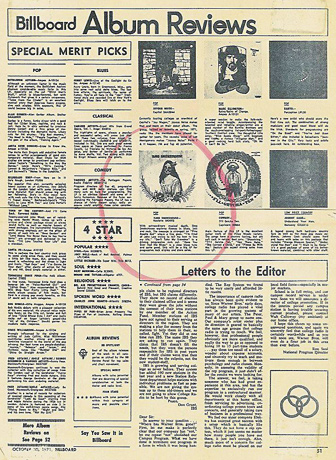
“With extraordinary musical depth, ILMO Smokehouse explores themes in blues, jazz and rock. The message is strongest on ‘Pine Needle Bed’ where a line goes ‘I’m tired of John Law trying to tell me how to live my life.’ ‘Devil Take my Grandma’ is a driving progressive rock cut. ‘Have You Ever Had the Blues’ is a slow blues tune and quite good. This will be a big LP for progressive rock airplay and store sales.”
Billboard MagazineBix Clements, the former American Music Band bassist, eventually came back and played with ILMO Smokehouse. About this time, we also hired a new guitarist. I didn’t know this when I hired him, but he had a habit of stopping right in the middle of a song on stage. In all my years of playing, I’d never had this happen. It completely freaked me out. I remember coming home and telling my wife Gail, “This is it. I’m hanging it up. I can’t play live anymore.”
Gail thought I was kidding, but I kept my word. The next day I talked to Dennis about my decision. I offered to continue to manage the band and Gail said she would continue to book the group though her talent agency.
Soon after that, Dennis and the other band members moved to Detroit where they made a name for themselves as Rio Smokehouse. Dennis eventually returned to Quincy and the final version of ILMO Smokehouse took shape.

Steve Gaines played with ILMO Smokehouse before joining Lynard Skynard. The last ILMO Smokehouse, from left: Gaines, Bill Haller, Dennis Tieken, Ron Shumake.
By this time, Ron Shumake, my former bassist from the Rockers, had returned from the army. He told us about a guitarist and singer from Miami, Oklahoma named Steve Gaines. Ron called Steve up and convinced him to come to Quincy. Everyone seemed to get along and Steve stayed. We brought in Bill Haller on keyboards and I managed the band.

In concert at Western Illinois University, Macomb, Ill. From left: Steve Gaines, Dennis Tieken, Bix Clements.
One day, Steve came to me and said his sister, Cassie, who sang backup with a group called Lynard Skynard had called him about an opening in the band. I told Steve that it sounded like a great opportunity for him and I tore up his contract with me. Steve went on to be an integral part of Lynard Skynard and it was a kick to hear him perform some of his same original songs with them that he had done with ILMO Smokehouse. Sadly, Steve perished in the infamous plane crash a few years later, but not before achieving fame and fortune.
Within just a few years time, ILMO Smokehouse made numerous concert appearances, both as headliner and as support act including shows with MC5, Big Brother & The Holding Company, Canned Heat, Blue Oyster Cult, Ted Nugent and The Amboy Dukes, Brownsville Station, James Gang featuring Joe Walsh, Sugarloaf, Crow, The Flock and B.B. King. We had become a part of Midwest music lore but, once again, it was time to move on.
Smokehouse Daze
By Terry Hawkins
Rod and Ron…Dennis and Steve
Eatin’ pork-n-beans out of the can
Wearin’ crazy hats
and shirts with no sleeves
Freddie had Smokehouse
With Bix and Slink Rand
The hearse was always full of friends of ours
And half way to Meyer
Dudes would get out
Just to get in someone else’s car
Gibsons, Fenders, and Gretsches
Hittin’ me in the head
I’d give a night’s pay for a king size bed
Headin’ for Detroit, Wier, me and Ed
Picking up the stuff just like we said
Gettin’ back to Quincy
And doing it all
No matter how fast Fred wanted us to move
We’d stall
But I think we all
Had a ball
“Bands like ILMO Smokehouse are the blood and bare bones of our music, our very fiber…”
Note: Bill Knight is an award-winning journalist who has taught at Western Illinois University since 1991.
By Bill Knight, EditorNote:
Terry Hawkins is a published author, poet and former member of the ILMO Smokehouse road crew. He is currently on sabbatical from his teaching position at the American University in Bangkok, Thailand.
Little White
It’s hard to think about the ILMO Smokehouse days without mentioning Little White. It was a tiny, rundown rental house on the wrong side of the tracks in Quincy and I’m not sure who even paid the rent. Some of the band members and girlfriends lived there on and off and for a short time the basement was our rehearsal location.
It was a place of continuous partying and when I think back, it was pretty scary. There were strange people coming and going all hours of the day and night and most of the time, no one knew who they were. I lived there for a short time with only a sheet for a door separating my room from the insanity. I was the only one that was working a day gig in addition to band duties and with continuous loud music, laughter and partying, it was really hard to get any sleep.
In back of Little White sat a small, dilapidated shed. When the landlord spotted a new lock on the door, he called the police who found several bales of fresh, Mississippi River bank weed inside. Due to my local popularity and because I had been seen going to and from the house numerous times, the police tracked me down at a local movie theatre where I was watching a matinee with my 7-year-old daughter. They hauled me out into the lobby and handcuffed me right in front of her and took me to jail.
The truth is that I didn’t know a thing about that weed, but the ensuing publicity was pretty embarrassing. The local newspaper and television coverage was very thorough. Of course, I was released the next morning, but the righteous people of Quincy had made me quite a renegade celebrity. The funny thing is the attendance at our Ilmo Smokehouse concerts grew bigger than ever after this. You know the old saying, “There’s no such thing as bad publicity.”
Transportation Nightmares (or the Show Must Go on)
The problems associated with band transportation to and from gigs is a story in itself. Imagine getting a group of musicians together and then add a whole band’s worth of equipment, a road crew and entourage to the mix – anyone would have to be crazy to travel across country like that.
Consequently, the vehicles that got us from gig to gig almost took on their own personalities. We spent so much time in them that they became like another band member after a while.
During much of the Freddie Tieken & the Rockers days, we traveled in a converted hearse. What didn’t fit in the back of the hearse went in the casket box on top or in a trailer pulled behind us.

The “Flying Magwheel Gaschamber” Cadillac hearse.
One New Years Eve we brought in the new year playing at The Barn in Quincy. As soon as that gig was over, we loaded up the equipment and headed off to play a breakfast dance at a black club in Hannibal, Mo. Well, I guess we took a highway curve too fast, because the hearse door came flying open and half the equipment (my sax included) went flying across the road. We threw everything back in the hearse and proceeded to the gig. I had to bend a few sax keys back into place, but we made it and played until 7:00 am.
And then there was the time we were rolling down the highway when the suicide door flew open and our vocalist Diana Rogan went flying out of the hearse. Luckily for Diana, the band’s resident genius/songwriter Roger Wegehoft managed to grab her leg and hold on to her until we were able to come to a stop. That was quite a sight to see her half in and half out of the car at 70 miles per hour. Roger is also the one who dubbed the hearse “The Flying Magwheel Gas Chamber” due to the smell that often permeated the vehicle from its leaky exhaust system.

Fred’s 1956 Chevy convertible pulled many band trailers back in the Rockers’ days.
On our way to a gig in Burlington, Iowa I happened to look out the driver’s side window and there was the trailer that was supposed to be behind us rolling along beside us. The next thing I knew there were wheels and metal flying every direction and our equipment bouncing all over the highway. We had a caravan of fans traveling with us in their cars but they didn’t even notice the catastrophe and drove on by. Finally they realized we were nowhere in sight and came back to find us. We loaded everything we could in their cars and made it to the gig. That time my sax wasn’t quite so lucky and I had to borrow one from a high school band student. Fortunately, our P.A. system and most of our amps were those Kustom Naugahyde quilted jobs and they didn’t even get a scratch. It was as though they were made for bouncing down the highway end over end. The band should have done an endorsement for Naugahyde after that incident.
Around the time I changed the name of the band to Freddie Tieken’s American Music Band, Charlie Parker joined the group on keyboards. Charlie had purchased his $14,000 Hammond organ with insurance money he received when he lost his leg in a motorcycle accident. One of the first nights he played with us, he stabbed himself in his wooden leg as the rest of the band looked on in amazement. I’ll never forget the sight of Charlie standing there with a quivering knife handle protruding from his leg. Finally Charlie let out a maniacal laugh and we snapped back to reality. He was always doing crazy things like.that.
Once, we were returning from a gig in Colorado when we ran out of gas out in the middle of nowhere in Kansas. It was about ten degrees below zero and Russ Phillips, our trombone player, volunteered to hitch a ride to the nearest town and bring back some gasoline. His journey took several hours and by the time he returned we were in preparations to burn Charlie’s wooden leg to keep.warm.
Upon returning from another long road trip in a freezing snowstorm, we parked the hearse and piled out as quickly as we could. As we were getting ready to leave for the next gig several days later, Ron Shumake announced that he hadn’t been able to locate his electric bass. It wouldn’t be hard to miss – it was all hippied up with dayglo peace signs. His bass was nowhere to be found, so he had to borrow one.
A couple of days later we were rolling in from another trip. It was a beautiful winter day and the sun had melted the snow. As we pulled in, there was Ron’s bass proudly sticking out of the ground, just like the “Hard Rock Cafe?” sign. Ron ran over and chipped it out of the icy ground. He played it at the next gig and the amazing thing is it hadn’t even gone out of tune.
Late one night as we were both returning from our separate gigs, I sat next to Tina Turner at the counter of Fern’s Restaurant in Hannibal, Mo. eating bacon and eggs. What a thrill that was! After all, Ike & Tina Turner were my idols. As we were driving away from Fern’s some redneck ran up and started stabbing our tires. The idiot was actually rolling on the ground, stabbing at our tires as we drove along. The hero of this incident was Terry Hawkins, my good friend and then roadie who volunteered to change out the tire for the spare in subzero
temperatures. What a night.
The Flying Magwheel Gas Chamber was always parked on the street in front of Little White when the band wasn’t on the road and I liked to keep an eye on it. One morning I drove by and did a double take – the passenger side door was missing! I thought I was seeing things so I turned around and came back by. Sure enough, the door was gone. As the story unfolded, I learned that a couple of roadies had taken it out on the town the night before and somehow lost the door. I never got to the bottom of the missing door mystery, and that’s when the ILMO bus entered my life.
The ILMO Lady Rules the Highways
I had recently changed the name of the band to ILMO Smokehouse and decided that, since the hearse no longer had a passenger side door anyway, it was time for some new transportation. I found a really nice Flexibus (like a Greyhound) from a regional bus line. The bus was purple and white and I painted a very large portrait of the ILMO Lady – the same one who would eventually grace our album cover – on the back.
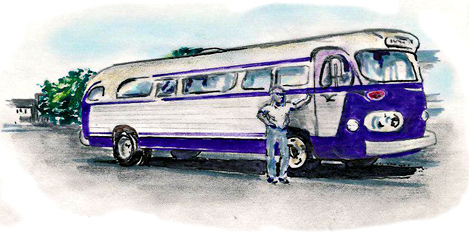
The one and only ILMO Smokehouse tour bus.
Well, that bus drew way too much attention and we must have been stopped at one time or another by every policeman, narcotics agent, state trooper and detective in the Midwest. It was completely stripped down on several occasions, once just outside a rock festival in southern Missouri.
On another occasion, we were stopped by an Illinois state trooper for having a recreational vehicle license. He said it didn’t qualify for a recreational license since we were using it for commercial purposes. I had gotten the RV license because it was so much less expensive than the commercial plates. Desperate, I pleaded our case. I told him that since there was no one on the bus making any money, our activities must be recreational. I still can’t believe it, but he looked around the bus, shrugged his shoulders, walked back to his car and drove away.
Mike Carr was our bus driver and a more mellow and loyal person never existed. Mike drove us many of thousands of miles around the country in that bus. I remember we had a couple of albums that were his favorites and he would play them continually long after the band had fallen asleep. I can’t count the number of times I have awakened to the sounds of Steve Miller or Mad Dogs and Englishmen. I think I have Rita Coolidge’s voice permanently implanted in my brain. Another person who figures prominently in my memories of those days is Fishhead, the band’s spiritual advisor. What I can’t remember is exactly what were his duties as spiritual advisor. Fishhead lives near my brother Dennis and they still get together frequently.
I eventually had to get rid of the bus. It was just too expensive to maintain. It as sure fun while it lasted though. I’ll always remember the look on the faces of hitchhikers when we pulled over to pick them up. They would climb the front stairs of the bus, gaze at all the people inside and get a look on their faces like they had just entered the Twilight Zone. I guess, looking back, that was fairly close to the truth. It also was fun to watch the looks on the faces of people at truck stops as we all came piling off the bus. We were no doubt a motley group.
The Smokehouse Limo
In the mid 70s Smokehouse traveled in style in their own stretch limo while the road crew drove a box truck containing the equipment. Willie Dale, the bass player, usually drove the limo. One night after a late gig, he dosed off behind the wheel and the limo went flying down into a ravine. The road crew who was following behind the limo in the truck had been given strict orders to follow the limo at all times since they had gotten lost on several occasions. So, following orders, the truck followed the limo into the ravine.
It was really a smooth ride, but that limo was always giving us trouble. When we had the transmission replaced at Amoco, we decided to get the lifetime warranty. Then on the way home, the engine blew up.
The road crew would usually leave several hours earlier than the band in order to set up the equipment before the band arrived. We had a series of one-nighters booked at major venues in the Chicago area and the band and I were just heading out in the limo when I got a call from the Illinois state police. The truck had run down into a ravine (again) and rolled over this time, but no one was injured. We got the location and hired a tow truck to pull it out of the ravine and set it back up. Upon opening the door we discovered that the road crew had packed the equipment in so tightly, nothing had shifted and everything was intact. Still over 300 miles away, we headed for Chicago and we weren’t even late for that night’s engagement.

Smokehouse road crew Rick Chapman and Gary Tieken (Freddie’s son) get ready to head out to the next show.
In another snowstorm in another town somewhere in the middle of another cornfield in the Midwest, the road crew had driven all day and somehow managed to make it to the club and get the equipment set up and ready for the band. The limo was broken down, so Willie had gone ahead with the equipment and Dennis and Micki were riding with Gail and me in our car. The car’s heater kept icing up and we thought a few times were going to freeze to death in the middle of nowhere. Warnings to get off the road were coming over the radio. We finally made it to the club just a few minutes after the band was supposed to start. The club owner, realizing that there would be a very light crowd because of the storm, seized upon this opportunity to inform us that he had cancelled the show because the band was not there on time. Well, that’s show biz, so the road crew packed up the equipment and drove off into the snowy night. Just one slight problem though – they had forgotten to roll down the truck’s back door. By the time they realized what had happened, equipment had fallen off into snow banks for several blocks. It took the rest of the night to dig everything out and load up again.
Ch-Ch-Ch-Ch-Changes
By 1973 and I was enjoying my role behind the scenes in the music business. I found it was every bit as exhilarating for me to work with other bands and musicians as it was for me to front my own group and I got a lot of enjoyment from playing sax on occasional recording sessions. One session that particularly comes to mind was when I played sax on a single by the great blues man Luther Allison.
Gail and I purchased a rundown Victorian mansion on Spring Street in Quincy and completely renovated it, doing all the work ourselves. I had left my position as designer/art director at Creative Printers & Advertising and started my own design firm. I built a recording studio and rehearsal facility in the basement, the talent agency and design offices were on the second floor and we lived in between.

Fred’s second Quincy, Ill. studio was known for great recordings and late-night parties.
Groups that passed through the new studio include Smokehouse, Pistol Whip, Uptown Strings and a country band, Cross Country, who recorded an incredible single entitled Rainin’ in Milwaukee. I can’t imagine why that one didn’t get picked up.
Bob Navolio, a good friend of ours who owned Bob’s Be Bop Records, brought his group Bluebird in for a session that produced some smokin’ blues tracks. I sat in on sax and had a great time. Recently, I moved everything that I could to CD because those old analog tapes are literally falling apart.
 Gail’s agency, Armageddon Talent, was doing well and she had an average of thirty nights per week in bookings. Gail’s friend Cindy Altgilbers worked with her for a while and another friend, Donna Doss, helped out occasionally. There weren’t a lot of talent agencies around back then. We had a great working relationship with some of them like Nick Caris from DMA in Detroit. We would book each other’s acts and try to fill in open dates. For others, we must have been a curiosity because they were always calling, quizzing Gail about what groups and what facilities she worked with.
Gail’s agency, Armageddon Talent, was doing well and she had an average of thirty nights per week in bookings. Gail’s friend Cindy Altgilbers worked with her for a while and another friend, Donna Doss, helped out occasionally. There weren’t a lot of talent agencies around back then. We had a great working relationship with some of them like Nick Caris from DMA in Detroit. We would book each other’s acts and try to fill in open dates. For others, we must have been a curiosity because they were always calling, quizzing Gail about what groups and what facilities she worked with.
One day, I remember Cindy answering the phone and telling Gail that some jerk wanted to talk to her. That “jerk” was Irving Azoff. He worked out of Champaign, Illinois at the time, managing and booking local and regional acts, much as we did. Gail said he was actually very polite but seemed a bit preoccupied with what we were doing. It’s funny to think that Irving Azoff was ever interested in our activities since he went on to become one of the biggest forces in the music business, managing acts such as Christina Aguilera, The Eagles and Fleetwood Mac to name a few. But that’s the crazy thing about the music business.
A local entrepreneur, Larry Million, came to me and asked if I would work with him on talent bookings for his new club, The Catacombs. It was a beautiful, sophisticated club and walking in, you’d swear you were in New York or L A. We booked in some really top name groups for him including Tony Williams Lifetime and Cheap Trick.
The Fillmore Midwest

Around about this same time in the mid 70s, Gail and I produced a heavy schedule of concerts at Turner Hall in Quincy with groups such as Rush, Savoy Brown, Captain Beyond, Ted Nugent, Cheap Trick, Head East, Smokehouse, Ruby Starr & Grey Ghost, Luther Allison and Starcastle. Sometimes we would have all-day shows on Sunday with eight local and regional acts. We had tremendous crowds for these concerts and the line would start forming hours before the show. Everyone knew they were going to have a really good time and hear some great music and we did all we could to make it a party atmosphere. People began referring to it as the Fillmore Midwest.
One night we had Ted Nugent booked and there was a terrible snowstorm. I remember driving to Turner Hall with a feeling of dread, knowing that we would lose a ton of money because no one would brave the storm to get there. When we pulled up, there was a line of people from the door all the way down the block and around the corner! It turned out to be one of the best crowds and best shows we ever had.
After the Turner Hall shows, groups would usually end up in my recording studio jamming until the wee hours. What a great time that was and what amazing tapes I ended up with! One night I had the guys from Cheap Trick and Smokehouse together and we ended up with the “Cheap Smoke” tapes.
Turner Hall has quite a history. Frank Heck, the hall’s owner, had produced shows there in the 50s and early 60s. It was a big part of the music scene then with groups such as Ike & Tina Turner, BB King, Little Milton, Bill Doggett, Lionel Hampton, Fats Domino and, of course, Freddie Tieken & the Rockers on the lineup.
By the mid 70s, the old one-foot-high stage riser was getting pretty distressed and didn’t meet the rider requirements of many of the acts we were bringing in. The last straw was one night when I saw Ted Nugent stick the neck of his guitar through one of the holes in the wood. The next day I asked Frank if he would mind if I built him a new stage. We used lumber from a building that was being torn down nearby and built a taller, concert-quality stage.
Frank Heck is gone now and I heard the new owner still rents it out for concerts but I’m certain it will never rock like it did in those days. I do know that whoever plays there has a really nice stage to work from.

The dynamic stage presence of Smokehouse, from left: Willie Dale III, Dennis Tieken, Micki Free.
Smokehouse – The Ultimate Flash
My brother Dennis and I had picked up the remnants of ILMO Smokehouse to form a three piece power trio, Smokehouse. We worked with several bass players including Craig Moore (formerly of ILMO Smokehouse) and the great John Sauter who has played with Mitch Ryder & the Detroit Wheels, Buddy Guy and Ted Nugent.
We eventually developed the lineup that would earn their name as The Ultimate Flash, featuring Dennis Tieken on drums, Micki Free on Guitar and vocals and Willie Dale III on bass and vocals. My rehearsal facilities and recording studio provided an ideal environment for the band to fine-tune their original material and work on their stage show.

John Sauter played bass with Smokehouse before joining Ted Nugent. Smokehouse, from left: John Sauter, Dennis Tieken, Micki Free.



Considered by many to be one of the best rock drummers of all time, Dennis Tieken started playing professionally when he was 14 years old.
At every show, Dennis’ drum solo is a highlight. He has the fastest double bass drum I have ever heard and he would roll them like thunder as he used his drumsticks as motorcycle handlebars. I recorded his solo in my studio and we would play it behind him on stage so that he would play a duo with himself. It was an extreme wall of sound! Then he would leave his drum set and come to the front of the stage as the recorded version of his solo was playing. Dennis and Micki would play timbales together while the lights were flashing and smoke was filling the stage. The crowd would go crazy and it was a ton of fun.
Micki Free was fairly young when he joined Smokehouse. He had put together a band with some other local musicians and Gail was booking dates for them. After they played a few warm up gigs with Smokehouse we decided to give him a shot with the group. He was kind of like a diamond in the rough and we recognized a lot of talent there that hadn’t been unleashed. He had God-given good looks and a natural sense of style. He had star written all over him and within a short time he became a good and then a great guitarist, developing his own unique sound with heavy power chords and melodic solos.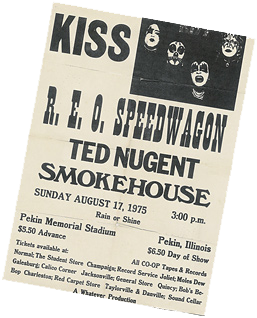
We had become friends with Willie Dale III from Champaign, Illinois when he was playing with the very popular Finchley Boys and Gail added the group to her agency’s roster. When the Finchley Boys disbanded, we asked Willie to join Smokehouse. He knew how to pop those bass strings and he brought a funky but chic presence to the band.
Gail kept Smokehouse solidly booked, playing an average of three to four times a week. They were always on the road, mostly playing one-nighters to sell-out crowds. They were an extremely sexy band, attracting more than their share of attractive young women and anyone who enjoyed a party. Because that’s what you got every night with Smokehouse – a party!
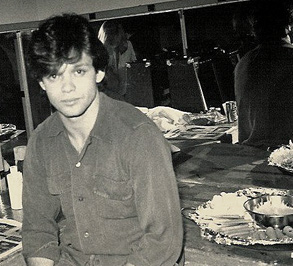
Gail shot this photo of a young John Cougar Mellencamp backstage at Danny Seraphine’s B’ginnings in Schaumburg, Ill., 1980.
I was working in my recording studio one day when Gail announced that I had a call from John Cougar. This was after he had broken with David Bowie’s management and long before he changed his name back to John Mellencamp. Anyway, John said he had heard of Smokehouse and would they be interested in being his band. You have to remember that at this time things were really cooking for Smokehouse and I thought his offer was ridiculous. I told him we might be interested but no way would we change the name to John Cougar & Smokehouse. End of conversation.
I designed and constructed a lighting system for Smokehouse that worked so well, other bands asked me to make systems for them. I used paint cans and gels and the effects were quite professional. The lights became so popular I ended up with a separate line of business, Lighting by Libra.
It’s hard to believe now, but in those days you could walk into any gun store and buy a keg of gunpowder. I would buy the stuff to use in the flash pots I had made for Smokehouse. We were really naive about the dangers involved and I don’t know what kept us from getting blown to bits.
One night a promoter friend of ours, Len Trumper, invited us to a Kiss concert at the Springfield, Illinois armory. It was Kiss’ first tour and it was one of my most memorable music experiences. We were right in front of the stage. They were so high energy and exciting and their pyrotechnics were amazing. The minute their gigantic flashpots went off, we saw all these guys from the armory milling around the stage. They looked extremely worried but we assumed they were just surprised by the show. We later were told that there was ammunition stored beneath the stage and the armory staff expected to see the entire armory blow at any minute.
Another time at a large nightclub in Carbondale, Illinois the Smokehouse roadcrew had my homemade flashpots set up on the front of the stage as usual. They were poised and ready to fire at the appropriate time during the show. The dance floor was packed that night and one guy had set his sport coat on top of one of the flash pots. No one noticed the coat so when the flash pots went off his coat shot about 15′ in the air. When it came back to earth it was flaming. Without a blink, this guy picked up his coat, brushed out the flames and strolled off with his coat over his arm as though it had all been part of the show. It was crazy. Things like that were always happening with Smokehouse.

Fred Tieken managed and produced Smokehouse, The Ultimate Flash, while wife Gail handled bookings and public relations.
One thing I remember about Willie Dale is that he loved to drive. Sometimes he would drive the equipment truck but most of the time he drove the band’s stretched limousine. It was so much fun riding to gigs with Dennis, Micki and Willie. They were as high energy off-stage as they were on-stage and there was never a dull moment. When we stopped at a large truckstop, Willie would head immediately to the truck drivers’ reserved section. He would use the private lounge area and even avail himself of the showers while there. I can’t even imagine what must have been going through the other drivers’ minds.
I should also mention someone here who was virtually the fourth member of Smokehouse, Micki Free’s brother, Roger Davis. As head of the Smokehouse road crew, Roger would drive the truck to the gig, supervise the road crew during setup, run the sound and lights and all the pyrotechnic special effects as well, and then tear down and drive to the next gig. What a trooper.
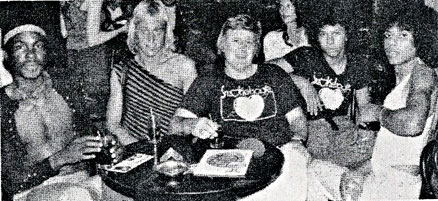
Relaxing after a show, from left: Willie Dale III, Dennis Tieken, Fred, Roger Davis and Micki Free.
Another integral part of the Smokehouse road crew was Rick Chapman. He was really dedicated to the group and worked so hard for those guys. He always brought a great rock’n’roll attitude with him.
So here they were– a stylish, pretty, heavy, funky power trio from a small Illinois river town. Smokehouse could wow them in Chicago and in the middle of the corn fields. With Gail and I providing management, booking and public relations, they were making quite a name for themselves.
Even though it was now the mid 70s in America, we were still faced with racial and social prejudice on many occasions while on the road. Once we sat at a Denny’s in Des Moines, Iowa for about a half an hour before Gail finally asked a server to take our order. She was told that they would not be taking our order and we were getting pretty hungry so we left and found a place that would serve us. On another occasion, we were told that we couldn’t stay at a Ramada Inn in St. Louis, Missouri because of our long hair. It is ironic to note that the Ramada Inn logo at the time featured a long-haired guy carrying a lantern and wearing a funny outfit.
Every minute they weren’t touring, we were in the studio working on demo tapes to send to producers and record companies. With all the press we were getting, I was able to generate a lot of awareness of the group within the industry and we started getting some interest from the demos.
Vernon Gibbs who was head of A&R for Mercury Polygram records came to see Smokehouse when they played the Springfield, Illinois Coliseum with Rush. He was really interested in signing the group to his label, but felt we needed to tweak the demos before presenting them to the company. He came to Quincy, stayed at our house and worked with me and the band in my studio.

Mercury Polygram A&R Director Vernon Gibbs works on demo tapes at Fred’s Armageddon Studio in Quincy, Ill.
Vernon was a big-city guy who had never really been outside the New York area. I took him riding on the back of my motorcycle and we made our way to Meyer (remember, population 100). I’ll never forget, when we got to the top of a hill, Vernon made me stop so he could look out over the countryside. I grew up taking this all for granted but it seemed like paradise to Vernon. He even picked out the spot where we would have our signing party with Mercury. I finally got him back on the motorcycle and we drove on to Meyer where I introduced him to my mom and dad and my aunt Neva, who by that point in her life was about 4 feet tall and a real character. When I introduced Vernon to her, she looked him up and down and instead of saying Hello, she simply said, “I see him.” I guess she felt she couldn’t speak directly to a record executive from New York.
Vernon returned to New York with the tapes and I soon received an extremely exciting phone call from non other than Eddie Kramer who had produced albums for the Beatles, the Rolling Stones, Jimi Hendrix, Led Zeppelin, David Bowie, the Kinks, Derek & the Dominos and AC/DC, just to name a few. He told me he had listened to the Smokehouse demo and was ready to produce the group just as soon as they were signed. I hung up the phone and thought, “Wow, Mercury Polygram and Eddie Kramer, it just doesn’t get any better than.that.”
Well, as you can imagine, the champagne was flowing at the Tieken compound. By this time, we had decided that Chicago, 300 miles to the north, would provide a more suitable home base for a band that was signed to a major label. Smokehouse had already established a name for themselves there, so the move made sense. Gail and I put an offer in on a large house in Northeast Rogers Park — sometimes referred to as the United Nations of Chicago — and put our house in Quincy on the market. Then, one day Dennis called to say that he had just spoken with Micki who informed him that he was leaving the band and moving to California with a friend. We had months of dates booked and negotiations had been progressing with Mercury. What a shock! As I mentioned, Micki was very young and inexperienced when he joined the band. I think he fell victim to his own hype. Anyway, just as it was all coming together, he left us holding the bag.
The wheels had already been put in motion, so Gail and I proceeded with our move to Chicago. Along with Dennis, we tried to reform Smokehouse with Kevin Smith on guitar and vocals, but the momentum had been lost. By the time we were able to get a group rehearsed and back on the road, it was almost like starting over. Needless to say, the Mercury deal was put on hold. Vernon asked for new demos, but I didn’t have the confidence in the new line-up to present anything to him.
With our help, Smokehouse had made quite a name for themselves. In addition to their busy headline schedule, they had appeared in concert with Rush, Kiss, REO Speedwagon, Ted Nugent and Van Halen. They had gotten media exposure that most bands only dream about. I really tried to put my heart into working with the new group, but I just couldn’t find the enthusiasm to give it my all and decided to call it quits. Dennis eventually moved back to central Illinois and revived the group with a new line-up, carrying on the Smokehouse tradition without me.
